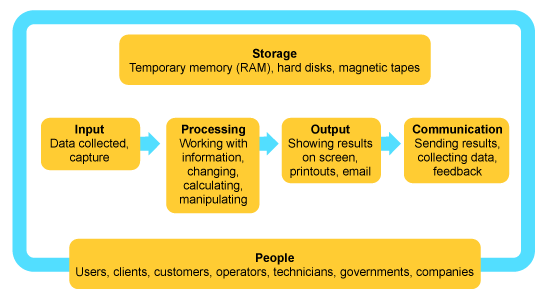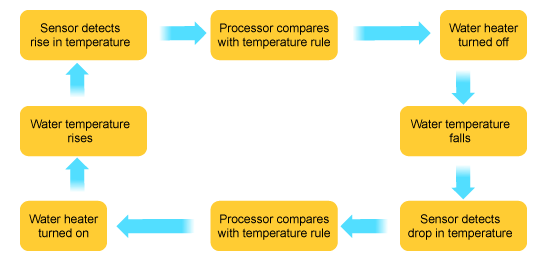Cards In This Set
| Front | Back |
|
ICT systems and their usage
|
The GCSE ICT course is all about ICT systems. You need to know the general structure of information systems, and how they work; the role of input, output, processing and feedback; and the integration of ICT devices and ICT information systems.
|
|
What is an ICT System?
|
An ICT system is a set-up consisting of hardware, software, data and the people who use them. It commonly includes communications technology, such as the Internet.ICT and computers are not the same thing.Computers are the hardware that is often part of an ICT system.This is why your GCSE is not just about computers but about how, why and when people use them. It is the power of computers and communications that has allowed ICT systems to become so important. Like any piece of equipment, the important thing about it is what it lets us do.
|
|
ICT Systems are used in a number of environments, such as:
|
|
|
The importance of ICT systems
|
By using ICT systems we are:
|
|
Types of ICT system
|
The three main types of ICT system to be considered for GCSE are:
|
|
Information systems
|
This type of ICT system is focused on managing data and information. Examples of these are a sports club membership system or a supermarket stock system.
|
|
Control systems
|
These ICT systems mainly control machines. They use input, process and output, but the output may be moving a robot arm to weld a car chassis rather than information.
|
|
Communications systems
|
The output of these ICT systems is the successful transport of data from one place to another.
|
|
Input, output and system diagrams
|
What comes out of an ICT system is largely dependant on what you put into the system to begin with.ICT systems work by taking inputs (instructions and data), processing them and producing outputs that are stored or communicated in some way. The higher the quality and better thought-out the inputs, the more useful the outputs.
|
|
Garbage In, Garbage Out (GIGO)
|
ICT systems cannot function properly if the inputs are inaccurate or faulty; they will either not be able to process the data at all, or will output data which is erroneous or useless.GIGO is a useful term to remember in the exam - it can help explain many issues such as why validation is needed and why accurate data is valuable.
|
|
(GIGO)
|
GIGO stands for Garbage In, Garbage Out
|
|
An ICT system diagram
|
A system is an assembly of parts that together make a whole. ICT systems are made up of some or all of the parts shown in the diagram. Various devices are used for input, processing, output, and communication.
|
|
ICT systems can be made of some or all of the parts shown.
|
 . . |
|
Feedback
|
It is sometimes good to have feedback in an ICT system. This is when the outputfrom a system feeds back to influence the input and the process repeats itself.A good example is a system set-up to control water temperature in a tropical fish tank. The temperature of the water is taken as an input from sensors. Processing takes place and the temperature of the water is compared against the pre-programmed parameters, eg maximum/minimum temperature. The outputs include the automatic decision to either turn on or off the heater to warm or let the water cool. The output, ie the change in the water's temperature, is then fed back by the sensors as an input and the process repeats itself.
|
|
A system that monitors the water temperature of a fishtank and reacts accordingly.
|
 . . |



